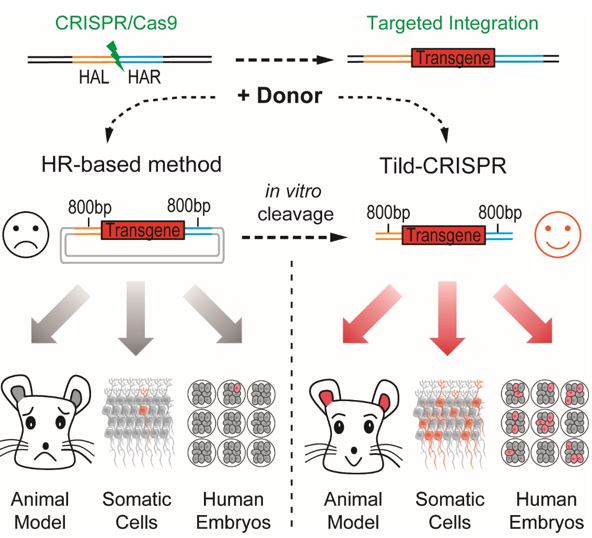Time:2018-05-22
A recent study published in Developmental Cell demonstrated that the efficient and precisely targeted integration can be achieved by Tild-CRISPR in mouse and human cells. This work was performed by researchers in Dr. YANG Hui’s Lab at Institute of Neuroscience, CAS Center for Excellence in Brain Science and Intelligence Technology, Chinese Academy of Sciences, in collaboration with the team of Dr. CHEN Zi-jiang at the Shandong Provincial Hospital Affiliated to Shandong University, RenJi Hospital Shanghai JiaoTong University School of Medicine.
This work successfully devised a new method called Tild-CRISPR, a targeting strategy using PCR amplified or precisely enzyme-cut transgene donor, yields knock-in efficiency in mouse and human embryos, as well as the mouse brain in vivo. With higher knock-in efficiency in mouse and human cells, Tild-CRISPR holds a great promise for applications such as studying gene functions in vivo and developing potential gene therapies.
CRISPR/Cas9-mediated genome editing has greatly facilitated targeted integration of transgenes both in vitro and in vivo. However, the more generally used homologous recombination (HR) is inefficient for achieving gene integration in animal embryos and tissues, although non-homologous end-joining (NHEJ)- or microhomology- mediated end-joining (MMEJ)-based methods can elevate the efficiency in some systems. Previous studies in this group have showed that in vivo cleavage of transgene donors with ~800 bp of homology arms could promote CRISPR-mediated targeted integration in animal embryos and tissues in vivo. However, technical barriers still exist in efficiently creating mice with conditional alleles or large insertion, and precise knock-in in human embryos.
In this study, based on CRISPR/Cas9 system, researchers designed a new targeting method termed as Tild-CRISPR (targeted integration with linearized dsDNA-CRISPR), a strategy in which a PCR-amplified or precisely enzyme-cut transgene donor with 800-bp homology arms is injected with Cas9 mRNA and single guide RNA into mouse zygotes. Tild-CRISPR exhibited the highest knock-in efficiency compared with all other targeting strategies with various types of transgene donor in mouse embryos. Various insertions, from 0.8 to 6.0 kb, could be precisely integrated into different loci. Compared with HR- or HMEJ-based methods, Tild-CRISPR showed robust DNA knock-in using in utero electroporation in the mouse brain. Importantly, the Tild-CRISPR method also yielded up to 12-fold higher knock-in efficiency than HR-based methods in human embryos, making it suitable for studying human embryo development and correcting pathologic gene mutation.
Overall, this work described Tild-CRISPR, a targeting strategy using PCR amplified or precisely enzyme-cut transgene donor. Tild-CRISPR yielded robust knock-in efficiency in mouse and human embryos, as well as the mouse brain in vivo, suitable for studying gene functions in vivo and developing potential gene therapies.
This work entitled “Tild-CRISPR Allows for Efficient and Precise Gene Knockin in Mouse and Human Cells” was published online in Developmental Cell on May 21, 2018. YAO Xuan, ZHANG Meiling and WANG Xing are the first authors with equal contribution. This work was supported by National Science and Technology major project, Shanghai City Committee of Science and Technology project, NSFC grants, Shanghai Key Laboratory for Assisted Reproduction and Reproductive Genetic, and National Research and Development Plan.

Graphic Abstract: Tild-CRISPR (targeted integration with linearized dsDNA-CRISPR), a targeting strategy using PCR amplified or precisely enzyme-cut transgene donor, yields robust knock-in efficiency in mouse and human embryos, as well as mouse brain in vivo.
 附件下载:
附件下载: